

Men of 1st Cameronians using a Vermorel spray for gas dispersal within a trench, May 1915. One man directs the nozzle, the other demonstrates the pump mechanism on the liquid ‘hypo solution’ reservoir. The device could also be operated by one man wearing the reservoir strapped on his back. Both men wear masks with eye protection. (IWM Q51647)
That poison gas might be used in war was appreciated in the late 19th century, and in 1899 an international convention at the Hague committed its signatories not to ‘deploy projectiles the sole use of which is the diffusion of asphyxiating or harmful gases’. Though well meaning the exact form of words would come back to haunt the nations attempting to avoid the worst horrors of chemical warfare. For the convention did not outlaw all gas, or its development, though it did appear to curtail the most likely delivery systems. The result was that the major nations continued to experiment with tear gases, which were not considered to cause long-term harm, and after the outbreak of war research with other substances was intensified. Small-scale and ineffective early usage of irritants by both the French and Germans went unnoticed, whilst Britain developed a substance known as ‘SK’, or ‘South Kensington’, named after the location where trials were made.
In April 1915 these Lilliputian efforts were suddenly overtaken when the Germans, working to methods devised by Professor Fritz Haber, employed the brutally practical expedient of opening large cylinders of chlorine gas at their own front line and allowing the billowing yellowish green contents to drift across to the enemy. So was born the gas ‘cloud’ or ‘cylinder’ attack. Launched at Ypres on 22 April by men of Pioneer Battalion 35, Operation Disinfekt came as a surprise to its victims. It should not have done, as an enemy prisoner named Auguste Jäger had recently been captured in possession of a respirator, and had mentioned gas cylinders. Elsewhere Belgian Army intelligence had corroborated his story. Lance Corporal Keddie of 48th Royal Highlanders of Canada was witness to the attack, whose worst effects fell on French colonial and territorial troops:
My company was in the reserve trenches … we noticed volumes of dense yellow smoke rising up and coming towards the British trenches. We did not get the full effect of it, but what we did was enough for me. It makes my eyes smart and run. I became violently sick, but this passed off fairly soon. By this time the din was something awful – we were under a crossfire of rifles and shells, and had to lie flat in the trenches. The next thing I noticed was a horde of Turcos making for our trenches behind the firing line; some were armed, some unarmed. The poor devils were absolutely paralysed with fear.1
As it turned out fear was justified, for chlorine was fatal if enough was inhaled, killing by irritating the lungs so badly that they flooded with fluid, effectively drowning the victim, who fell to the ground starved of oxygen, choking, face turning blue. About 4,000 were killed or injured that April afternoon. The French fled, in one famous German description, ‘like a flock of sheep’. Only with difficulty did the Canadians block the breach. Sir John French would call this attack ‘a cynical and barbarous disregard of the well known usages of war … as a soldier I cannot help expressing the deepest regret and some surprise that an Army which hitherto has claimed to be the chief exponent of chivalry of war should have stooped to employ such devices against brave and gallant foes’.2 W. A. Quinton of 1st Bedfordshires – who was gassed in another attack not long afterwards – described the experience as like having his ‘lungs burnt out’ and needles thrust into the eyes.3 Often the first impulse on getting a whiff of gas was to run, but all too often this involved leaving the relative safety of the trench to become a target for bullets.
Dramatic and dangerous as this debut of chemical combat was, post battle analysis would ascertain that gas was not a wonder weapon ready to win the war. First and foremost it was unpredictable – it required careful preparation to make an attack, but there was no guarantee that weather conditions would oblige. Wind in the wrong direction blew gas back across the attacker’s own forces; wind too strong would dissipate the fumes before they had a chance to reach their target. Moreover wherever it went gas would not discriminate between friend and foe, and it took organization to get sufficient troops to follow up close enough to the gas clouds to take good advantage of their disabling effects.
Naturally those on the receiving end now gave gas protection measures the highest priority. The very next day the Paris municipal laboratory was set to work, as simultaneously British headquarters issued its first anti-gas instructions. These were pretty desperate, and included the idea of rolling a handkerchief into a ball, putting it into the mouth and breathing through it. Prolonged exposure was to be combated by a ‘piece of flannel’ tied around the head and breathing in through the mouth and out through the nose. Within a few days the British and Canadians were battling in gas with a variety of improvised protections varying from cloth dipped in urine to face pads with tapes run up by the nuns of Poperinge. Failing all else marginal relief was sought from cotton bandoliers dipped in water. Soon alkaline solutions were being produced specifically for gas neutralization, and masks impregnated to much better effect. Thereafter there was a race between those developing more deadly gases and better ways to deliver them, and those devising new methods of protection. New gases were inevitably followed by new gas masks, or new filters to be fitted to existing masks. This struggle would last until the end of the war. In the process gas would demonstrate its horrible potential as a weapon of debilitation, fear, injury and ‘neutralization’, but it would never become as deadly as high explosive, nor – since both sides used it – could it ever give one side anything like a war winning advantage.
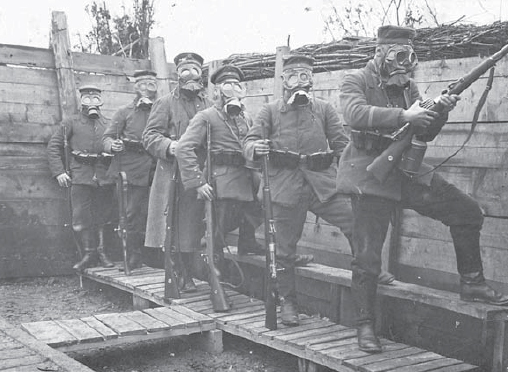
German soldiers in a firing position wearing the 1915 model rubberized fabric or ‘gummi’ type gas mask, with detachable filter. The NCO nearest to the camera demonstrates the action of the standard G98 Mauser rifle, showing how the cartridges are loaded into the five round integral magazine from the top, with the bolt open, using a charger. The trench is lined with planking and has both a fire step and duckboards standing clear of the earth floor. (Author’s collection)
Firing gas shells from artillery pieces became increasingly common from mid 1915, and quickly gained favour with German tacticians who saw this method of delivery as ideal for maintaining surprise and effective targeting of specific points. British theorists were less sure initially because the volumes of gas delivered by shells were relatively small, and if cylinders released gas, then guns were free to fire high explosive and shrapnel. Nevertheless shell delivery became increasingly significant with time, and many types of artillery weapon and mortar were eventually matched with a gas projectile. Gas shells came as a considerable surprise, hitting targets that were previously regarded as invulnerable to gas attack. In July 1916, for example, 1/8th Worcesters were working on a communication trench when they were suddenly bombarded with a new type of gas shell. Only eight men avoided some degree of gassing – and 400 were still unfit some time later. Gradually, however, gas ‘shoots’ became more familiar, and troops learned to recognize the distinctive sounds of the arrival of chemical munitions. Some projectiles opened with a ‘plop’, far quieter than high explosive; others a double bang.
Also in mid 1915 the Germans introduced a new lung irritant known as K-Stoff. Phosgene, much more virulent than chlorine, and more difficult to detect, was in use before the end of the year. On the downside phosgene was lighter and had greater tendency to dissipate, and was therefore often mixed with chlorine to produce a lingering toxic cloud. Various other toxic gases, including the so-called ‘arsenical compounds’ were introduced, but ‘blistering agents’ were arguably the most significant gas development of the latter part of the war. The most famous of these was initially identified simply as ‘H. S.’ or ‘Hun Stuff’, but, owing to its distinctive smell was soon known as ‘mustard gas’. The key point about ‘mustard’, also known as Yperite, or ‘Yellow Cross’ from the markings on German shells, was that it affected not only the respiratory system and eyes, but any part of the body it came into contact with. Soon after introduction it was causing more casualties than all the other German gas munitions combined. As the regimental history of the Liverpool Scottish explained:
It was impossible to avoid casualties in a heavy concentration of this gas. The box respirator protected the throat and eyes but the dense fumes which hung about shell holes attacked the skin – especially the softer parts of it – and caused painful sores. In these circumstances the kilt is not an ideal garment.
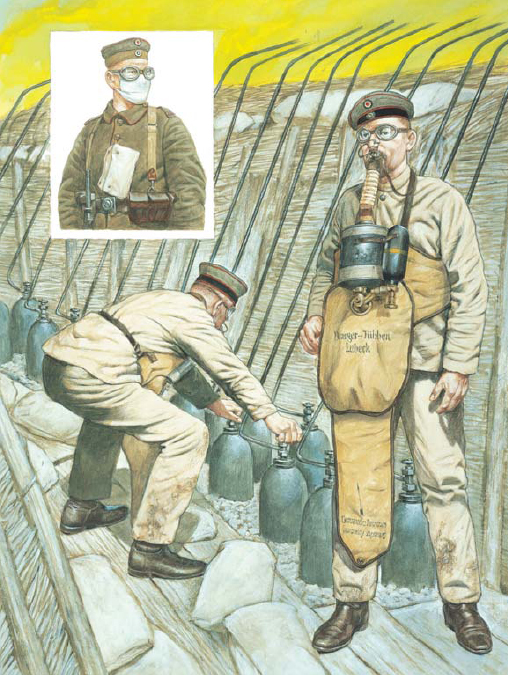
German gas Pioniere prepare cylinders for a ‘cloud’ gas attack, 1915. The containers are partly dug into the firing step of the position for stability and partial protection against shell splinters, forming a Flaschen (bottle or cylinder) battery. The pioneers wear the 1914 Dräger type Selbstretter or oxygen re-breather apparatus. The insert shows a soldier of 245th Reserve Infantry Regiment with the gas protection current for other troops in April 1915, the Reichpäckchen pad with tapes, which was stored in a rubberized bag on the uniform when not in use. (© Richard Hook, Osprey Publishing)
‘Mustard’ also lingered for a week or more depending on weather conditions, and both sides used it to hamper movement, or deny areas of the battlefield to the enemy. Private Dolden of the London Scottish had a narrow escape:
We came to a shell hole in which there was an unusual kind of yellow powder, and a peculiar smell. I took a good sniff and declared that there had been gas in the shells. This was something new… Robertson took a sniff and said it was not gas, and a long argument ensued during which we both took a few new sniffs and then went along to the dugout to call the Gas Corporal… He took a mild sniff and then chased off like mad yelling ‘Gas’… I was very lucky to get away with that ‘packet’ as lightly as I did, for I must have taken quite a lot of gas into my lungs with the many sniffs that I took. The ground had become so impregnated with the gas that all the troops were ordered out of the area, and the trench was put out of bounds. I was unwell during the morning, and had a shocking headache, and completely lost my voice… The next day Robertson was worse, and had to be led to the aid post with a bandage round his eyes, for he could not bear the light on them. There was a continuous stream of water running from my eyes, and they were very inflamed and sore. I was in chronic pain, as my head, throat, eyes, and lungs ached unmercifully. In addition the mustard gas had burnt me severely in a certain delicate part of my anatomy.4
Dolden’s story sounds incredible. Nevertheless those exposed to mustard gas for any length of time tended to lose their sense of smell, making them more vulnerable. Moreover concentrations could build up gradually, and a delayed effect, particularly where the gas was encountered in limited quantities, was a well-known phenomenon.
Some idea of the injuries caused by gas can be gleaned from the pages of the British official Medical History. Here are described the suffocating effects of chlorine and phosgene, and the terrible burns of ‘mustard’. Blister casualties might be virtually flayed or blinded, and some types of gas – like the ‘arsenical compounds’ – produced psychological as well as physical symptoms. Yet gas, for all its terrors, remained surprisingly non-lethal. According to 1915 British statistics, of 12,792 personnel treated for gas symptoms, only 307 died, and almost all of the others returned to duty. Of a sample of 23,626 treated for ‘gas poisoning’ in the latter part of the war 93 per cent were eventually fit to return to duty, and just over 3 per cent died. By contrast, statistics from 1917 showing casualties from all causes suggest that roughly half of bullet wounds were categorized as ‘serious’, and that in general almost 10 per cent of wounded men died. In short, if you could get medical help the chances of surviving a ‘gassing’ were very high, and a decent gas mask, and instruction on how to don it at the first sign of trouble, were correctly identified as the best way to combat the problem. Paradoxically, the evil reputation of the insidious menace of gas would be upheld over coming decades by the numbers of men who were gassed but survived. Larger numbers who were hit by shells and bullets never left the battlefields.
Considering the numbers needing to be equipped and the continual discovery of new gases, the invention, manufacture and distribution of new protection was surprisingly quick. In May 1915 the British brought in the so-called ‘Black Veiling’ respirator, which, although only a crude pad, was soaked in a ‘hypo’ solution, and undoubtedly saved lives. Almost immediately this was followed by the ‘Hypo’ or ‘Smoke’ helmet invented by Cluny MacPherson, a medical officer with the Newfoundland Regiment. The Smoke helmet was a flannel bag enveloping the whole head, soaked in hypo, and fitted with a mica window. The French, with a larger army and a longer front line, were a little slower to begin distribution of new masks – but soon they had their own equivalents. About 50,000 French ‘helmet’ types were distributed in late May, and a million ‘C2’ Compresse face pads were issued by mid August 1915. Not everyone received the new masks sufficiently quickly, and new German gases were soon testing the old face pads beyond their capabilities – but it was enough to blunt the full effects of the assaults in the spring and summer of that year.

Bombers of the 1st Scots Guards in ‘Big Willie’ trench at Loos, October 1915. The open Mills bomb box shows how they are packed: six at either end with a tin of igniter sets in the middle. A ‘key’ for removing the base plugs of the bombs was included under the lid of the tin. One of the guardsmen, left, wears his ‘PH’ gas helmet rolled up on his head; others carry them in bags on straps over the shoulder. (IWM Q17390)
From the Zonnebeke sheet, 28 N.E. 1, 1:10,000, corrected to 30 June 1917. ‘Passchendaele’ – now popularly synonymous with the entirety of the muddy Third Battle of Ypres, which commenced on 31 July and continued until 10 November 1917 – was actually two specific engagements within the larger campaign whose main objectives were to expel the enemy from the Belgian coast and relieve pressure on Britain’s allies. Thus it is the ‘First Battle of Passchendaele’ commenced on 12 October, with a second starting on 26 October. The German defensive line Flandern II ran south and west of the village, but by this time the emphasis was less on narrow continuous trench lines – which were in any case very difficult to maintain in this waterlogged terrain – but on wide zones, strong points and concrete works. Even by the time of the First Passchendaele the village had virtually ceased to exist. Its demise was witnessed by the war correspondent of The Times in a report printed on 13 October:
Nearly six weeks ago I described the village of Passchendaele, which stands on the summit of the ridge, as even then we could see it, with its many red roofed buildings still more or less intact among the uninjured trees. Since then it has changed. Our shells have stripped and splintered the trees, and only here and there bits of pink roofs remain over the area of tumbled masonry. While our men are fighting in the awful swamp region directly under and before this edge of the ridge, to the right the topmost ridge is in our hands … there is no possible question that our men are fighting with desperate determination to do all they set out so to do, and if they fail in any detail it will be the weather and the mud that stop them.

Passchendaele from the air, before and after the 1917 offensive that virtually obliterated the village. In the second photograph the only structure readily identifiable is the church, completely wrecked, but still maintaining its distinctive outline at the centre of the village. Now restored it incorporates memorial windows to 66th Division and the arms of Lancashire towns. (IWM Q42918A)
Mobility was achieved only with the most extreme difficulty over ground that in many places was now impassable even for tanks. A modest walking speed was maintainable only on duckboard tracks, which were easily destroyed and tended to channel movement. Maintaining direction also became difficult even with a map, because most things had disappeared. As Captain Glanville of 2nd Royal Dublin Fusiliers put it, ‘Mud awful, no trenches, no shelters, no landmarks’. Perhaps most important was the problem of moving artillery, supplies and ammunition, without which attacks could not even be attempted.
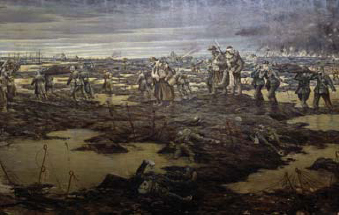
The Harvest of Battle by C. R. W. Nevinson, 1919. Together with Sargent’s better-known work Gassed this painting was a commission for the Hall of Remembrance. It was based on sketches that the artist made at Passchendaele. In a letter Nevinson described the picture as a ‘typical scene after an offensive at dawn. Walking wounded, prisoners and stretcher cases are making their way to the rear through the water-logged country of Flanders. By now the infantry have advanced behind a creeping barrage on the right, only leaving the dead, mud and wire; but their former positions are now occupied by the artillery. The enemy is sending up SOS signals and once more these shattered men will be subjected to counter-battery fire. British aeroplanes are spotting hostile positions.’ (IWM ART 121)
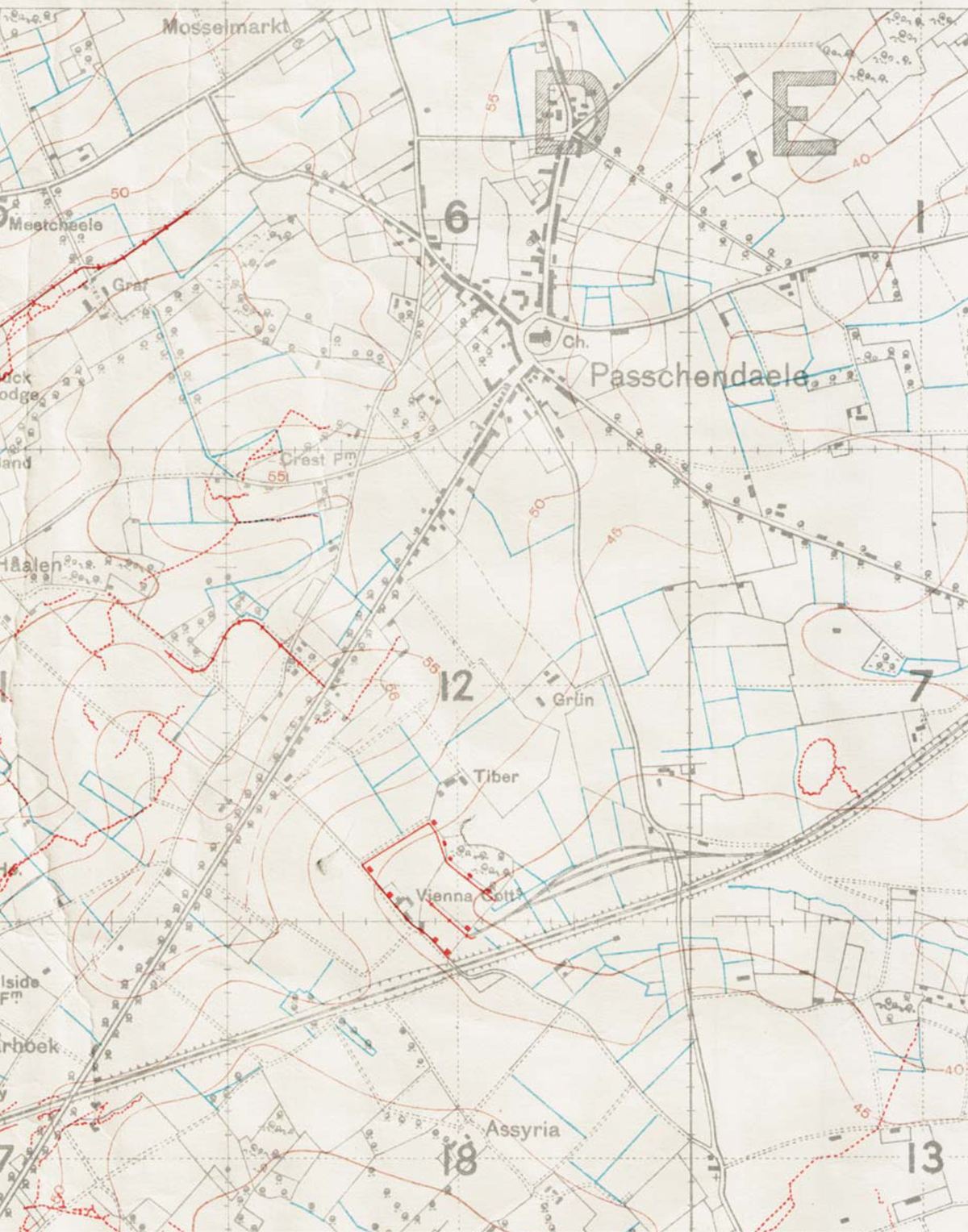
In the summer scientists at the Royal Army Medical College in London actually sought to get a head start on the gas weapon technologists. Having identified 70 possible gases that might be used, they set out to redesign the Smoke helmet to take account of the most likely possibilities. The result of this was the ‘Tube’ helmet, which had a mouthpiece valve for the wearer to breathe out; a double thickness bag of cotton flannelette; and two eyepieces. These were manufactured rapidly enough for every British soldier to be given one by mid November 1915. Improvement though they were, Tube helmets were hot and uncomfortable. Some, confused by the smell of chemical impregnation, even ripped off the mask prematurely in battle. They could also be the subject of ribaldry, as anybody failing to use the tube properly could cause the bag to inflate on his head, or let out extraordinary noises whilst struggling to exhale.
Captain F. C. Hitchcock of the Leinsters described his men’s first experience with Tube helmets:
It had talc eye pieces and a rubber breathing tube for the mouth; the ends of the respirator had to be tucked under the jacket collar. They were all drenched with a solution of hypo, and were very sticky, messy gadgets. We then marched the men off to watch a gas demonstration, a section of the Belgian defence trenches were covered over, and turned into a gas chamber. The gas was pumped out of a large cylinder… When we came out of the chamber our buttons were blackened and our watches had stopped.5
The British launched their own first gas attack at Loos on 25 September 1915, a ‘violent and continuous action’ in co-ordination with French forces, intended to drive the Germans out of their existing trench lines in this sector and cut their communications, so that they would be driven into a retreat. The operation would be heavily reliant on the shock and surprise of gas, but only a little more than half of the quantities first envisaged were available. Only by releasing the chlorine along with periods of smoke generation would it be possible to maintain the illusion of a large and continuous gas attack. In the event matters would go seriously awry, as was reported by Lieutenant A. B. White of the Royal Engineers’ ‘Special Companies’ tasked with the discharge of gas:
At first the gas drifted slowly towards the German lines (it was plainly visible owing to the rain) but at one or two bends of the trench the gas drifted into it. In these cases I had it turned off at once. At about 6.20am the wind changed and quantities of the gas came back over our parapet, so I ordered all gas to be turned off and only smoke candles to be used. Punctually at 6.30am one company of the King’s advanced to the attack wearing smoke helmets. But there was a certain amount of confusion in the front trench owing to the presence of large quantities of gas. We experienced great difficulty in letting off the gas owing to faulty connections and broken copper pipes causing leaks. Nearly all my men suffered from the gas and four had to go to hospital. Three out of five machine guns on my front were put out of action by the gas. Very little could be seen of the German line owing to the fog of smoke and gas. Our infantry reached the enemy wire without a shot being fired, but they were mown down there by machine gun fire or overcome by gas.6

A scene in an Australian front line trench at Croix du Bac, near Armentières, 18 May 1916. The soldier is adjusting a wind vane, which would serve as a direction indicator in the event of a gas attack. Note the 1907 type bayonet and helve for the entrenching tool worn at the soldier’s left hip. A spare bayonet, often used – against regulation – as a hook for equipment, is pushed into the parapet. A plank forms an alcove for munitions at bottom left of the picture. (IWM Q585)
German machine guns and errant gas put paid to many, but there was clear evidence that lack of experience with gas in the offensive was a contributory factor. Some panicked, believing they were gassed when they were not, and medical personnel had difficulty distinguishing gas symptoms from shock and fatigue.
Whilst Loos demonstrated how much was yet to be achieved, organized gas drills in defence of trench lines gradually improved both survival and confidence. Typical of the directions given to trench garrisons were those in force for 124th Brigade in late 1915 and early 1916. All ranks were to carry two Smoke helmets and have instruction on their use: helmets were to be inspected at Stand To. At the first sign of gas, whether detected by sight or smell:
the sentries will sound the gas alarm gongs and bells which are hung up at intervals throughout the trenches. On hearing this alarm every officer and man will at once adjust his Smoke helmet and fall in on his alarm post. Nobody will remain in dugouts. To make certain of the warning reaching everybody, the order ‘put on Smoke helmets’ will be passed from man to man throughout the trenches held by the division.
Officers in the trenches opposite to the enemy discharge were to send an ‘SOS’ call to the artillery, which was to commence rapid fire on the enemy line. When the gas cloud was thick enough to hide the enemy’s front parapets, machine guns and rifles would also open fire ‘in short bursts on fixed lines’ with the intention of breaking up any forming attack, causing casualties and piercing gas tubes. Even when not firing, rifle bolts and machine gun crank handles were to be worked back and forth occasionally to prevent corrosive gas from impairing the mechanism. Gas ‘gongs’, often made from old shell cases or requisitioned bells, were largely superseded by the latter part of 1916 by the ‘Strombos’ horn, a specially issued, and mightily loud, device reminiscent of a ship’s horn.
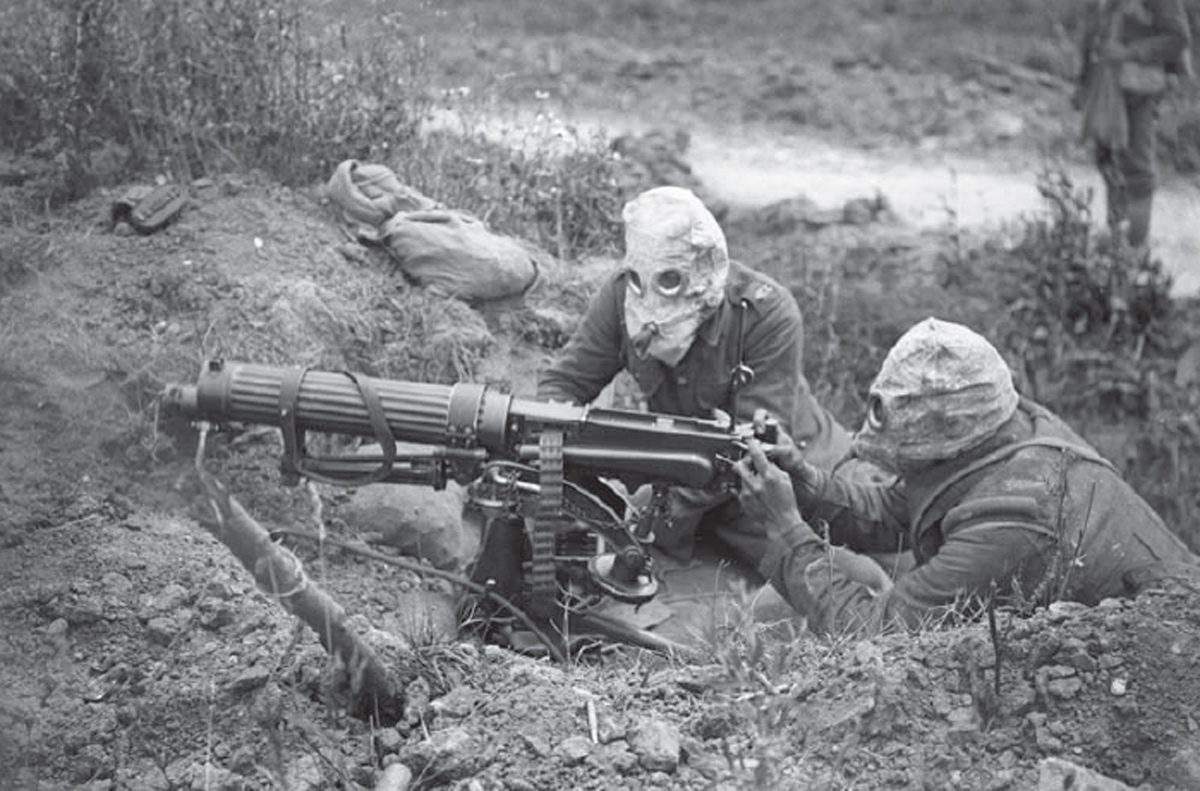
A British Vickers machine gun team of the Machine Gun Corps, firing near Ovillers during the battle of the Somme. The crew wear ‘Tube’ helmets against gas, and the gunner wears the special padded short waistcoat for carrying the gun over his shoulder. Though mounted on a full-sized tripod this weapon also has a light ‘auxiliary mount’ attached under the water jacket for rapid deployments. A full ‘gun detachment’ was six men: usually two manned the weapon; others brought up ammunition or acted as spares, and were able to take cover a short distance away when under fire. (IWM Q3995)
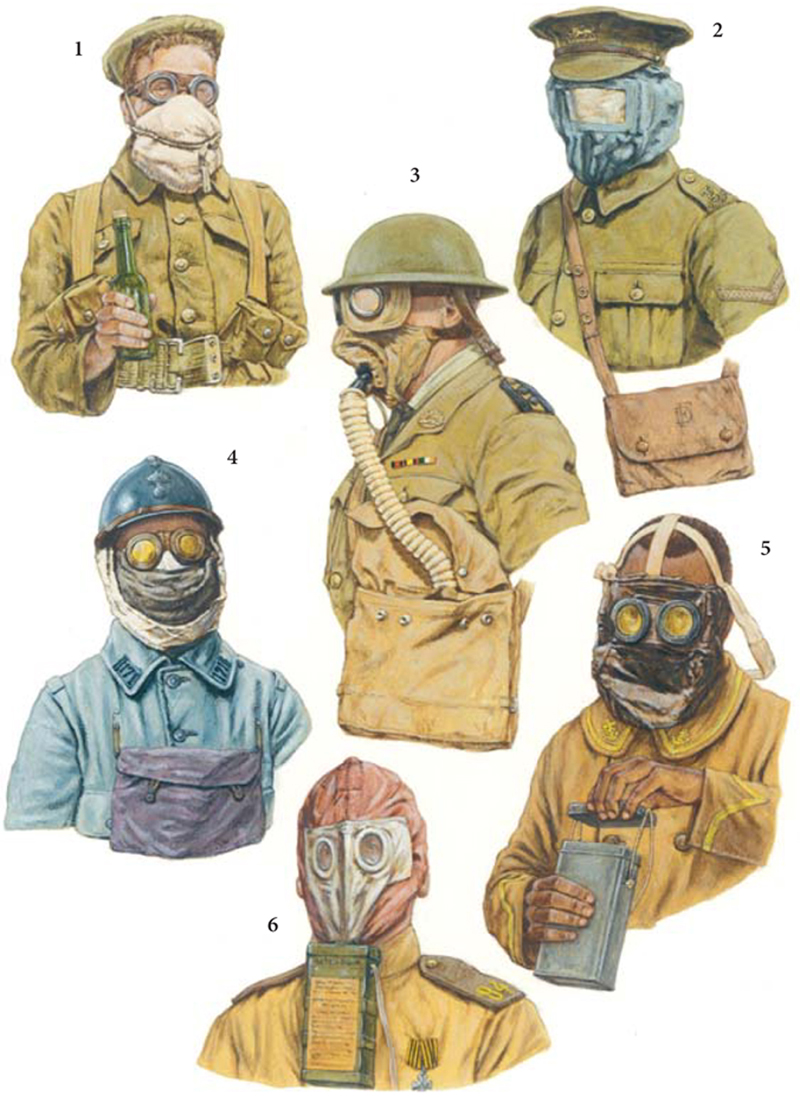
Illustrations showing a variety of Allied gas masks 1915-16.
1) British Barley mask, May 1915.
2) British Hypo helmet, Summer 1915.
3) British Large Box Respirator, June 1916.
4) French P2 mask, October 1915.
5) French M2 mask, summer 1916.
6) Russian Koumant Zelinski respirator, 1916.
(© Adam Hook, Osprey Publishing)
As well as protecting individuals from gas there were also attempts to sanitize the trench environment. ‘Gas curtains’ across dugout entrances were a good first line of defence, as Captain Christison of the 6th Cameron Highlanders explained:
The Germans mixed gas shells with ordinary shells and so compelled us practically to live wearing our respirators. We rigged anti gas blankets on frames at the entrances to our dugouts and behind each blanket was placed a flat tin containing chloride of lime; the men stood in this, crossed a further anti gas blanket and could then remove masks and get food and rest. Unfortunately, heat generated gas out of men’s clothing and some got gassed even with all precautions.7
Later in 1915 fans and sprays were also in use. The most commonly encountered spray in Franco-British service was the ‘Vermorel’, a backpack device with tube and handheld nozzle from which neutralizing chemicals could be sprayed in solution. Edmund Blunden described the Vermorels, not inaccurately, as ‘simple machines such as were used in Kent to wash cherry trees with insect killer’.8 Fans were far less effective than lighting fires which shifted gas by convection, warming bodies of air and thereby raising and dispersing the gas. Moreover, once properly ignited a brazier required little attention from troops who could then concentrate on their own personal protection. Nevertheless fans were seen, and the most infamous of these was the ‘Ayrton’. Designed by Hertha Ayrton, the Ayrton fan was effectively a piece of fabric on a stick with which the user flapped the gas away. Many landed up in the braziers.
Many photographs from early 1915 show German soldiers carrying a small wallet attached to one of their jacket buttons, and in this was contained a small pad type gas mask, but from the latter part of that year a much better sort of gas mask was deployed. This comprised a light rubberized fabric face piece with eyepieces, and a screw fit cylinder on the front containing the filter chemicals. Once a filter had been exhausted a new one could be fitted. Folds in the mask enabled the wearer to clean the eyepieces without removing the mask. Held tightly to the face by elasticated tapes, the mask could also be supported by a tape around the neck when hanging loose. Initially the new mask was carried in a canvas belt bag, but later in a small, distinctive steel cylinder. Soldiers with full beards or spectacles were warned that either of these might compromise the seal of mask to face. Solutions included whole or partial shaving and the wearing of special glasses with tapes rather than arms. A general issue of the new mask was completed on the Western Front at Christmas 1915.
General German instructions of July 1916 emphasized early warning, but allowed somewhat more flexible approach in terms of reaction:
The behaviour of men in the trenches must be governed by the local and tactical considerations. Shelters which are unoccupied during a gas attack must be made as air tight as possible. Those in which men remain during an attack are best closed by means of wetted curtains, which however must not interfere with easy egress. On the gas alarm being raised, every man puts on his mask as rapidly as possible, mutual aid being given to ensure correct fitting. If possible, arms should be wiped over with an oily rag. The Oxygen Breathing Apparatus and the reserve cylinders are to be laid out ready for use, so that oxygen may be given to any who are gassed. Everyone moves to his proper post. Moving towards the rear is always dangerous, as one thereby remains in the gas cloud. To stay in dugouts without masks is also dangerous, as the chlorine gas tends to remain in dugouts. Horses should be removed from the gas zone as far as possible… Once the gas cloud has passed and any hostile attack has been beaten back, the trenches and dugouts must be purified of any gas that remains. Men wearing masks are detailed to open the doors of empty closed shelters and dugouts, to produce ventilation … by lighting stoves.

An observation post of the 1st/7th Sherwood Foresters in a communication trench, Cambrin, 16 September 1917. The observer uses a telescope concealed amongst foliage. The position also serves as a gas alarm point and is equipped with a metal triangle and a mighty ‘Strombos horn’. The Strombos was to be used only in the event of a major event such as a cloud gas attack. (IWM Q6019)
French gas defence lagged somewhat behind the other powers in the middle period of the war, and consisted essentially of different types of goggles and impregnated pads. As late as February 1916 there were orders for a new ‘M2’ type pad, though this was at least much larger and incorporated eye protection. Later in 1916 an improved version appeared, and though this was capable of providing several hours’ protection, it was difficult to breath through and the eyepieces quickly misted up. The French Appareil Respiratoire Spécial or ARS mask, which was effective and had an appearance superficially similar to that of the German masks, was not distributed until 1917 when the first examples were issued to the artillery. Not all French troops had the latest mask until May 1918. Just how important gas defence, and indeed gas awareness, had become was underlined by a sample of 120 French gas casualties interviewed after a German chemical attack at Nieuport in June 1917. Of these 39 attributed their incapacitation to being surprised or their own carelessness; 15 to their removal of their mask too soon; 62 to an ill-fitting mask, or one which became displaced; and four to having an inadequate or obsolete mask. In short the vast majority of gas casualties were now avoidable if up-to-date, well-fitting masks were supplied to men who received warning of the attack, and put on their masks promptly and properly and kept them on.
The final types of British gas mask were the ‘box respirators’, the development of which commenced in 1915. These were a significant advance on what went before, because although made somewhat bulky by having a separate face piece and ‘box’ filter connected by a tube, they had a capacity to resist gas for long periods, and were fairly easy to upgrade with the addition of new filters to the existing box. Moreover the soldier did not carry the whole weight of the mask on his face, as was the case with the German ‘gummi’ mask, since the box rested in a satchel with a strap around the soldier’s neck and shoulders.
The first of the box types was the ‘Harrison’s Tower’ or ‘Large Box’ respirator, devised by Edward Harrison, chemist Bertram Lambert and John Sadd. The ‘box’ was created from a water bottle in which were three layers: lime-permanganate granules, fragments of pumice and fragments of bone charcoal. A corrugated flexible rubber tube ran from the box to a fabric facemask and a metal mouthpiece, which the wearer gripped in his teeth. With the ‘Large Box’ separate goggles were worn. As the latest word in gas protection this model was issued first to the ‘Special Companies’ of the Royal Engineers charged with gas warfare, and between February and June 1916 it was also supplied to machine gun and artillery personnel, who might well have to stay alert at their positions for long periods during gas attacks. From the ‘Large Box’ was developed the SBR or ‘Small Box’ respirator. This was more compact, included minor improvements to the valve system, and also incorporated the eye protection into the mask. This meant that the whole contraption was easier to handle, and if the bag was open on the chest and headgear removed, could be effectively donned in one fairly swift movement. The face piece of the SBR was made in four sizes. It was progressively issued to the entire British Army in the second half of 1916.

German gas protection measures:
1) The Atemschützer, a mask covering the nose and mouth issued in August and September 1915. Worn with nose clip and goggles this was issued with bottles of hypo solution for soaking the mask.
2) A paper fibre and gauze mask for messenger and rescue dogs c.1918.
3) Gas-proof pigeon box incorporating air filters.
4) Horse respirator. First issued in 1917, and made in three sizes.
5) Mask designed for the wounded, made of leather and shaped like a hood.
(© Richard Hook, Osprey Publishing)
American forces were given different types of Allied mask including limited numbers of the French 1916 model ‘M2’ pad. Nevertheless they were much more impressed with the performance of the SBR, and from October 1917 also manufactured their own version, which was dubbed the CE (or ‘Corrected English’) Box respirator. US production alone totalled about 5 million masks. Eventually the French and Americans would also lead the way in the development of gas-proof clothing to prevent skin contact with ‘blister’ gases. The Americans also issued their own anti-gas instructions, generally developed on British and French lines. Those of 1917 suggested that machine gun teams were key to successful defence under gas attack, and these had two main options. The first of these was to open fire on the enemy trench. This interrupted any enemy infantry attack, raised morale of friendly troops, and kept gun mechanisms free and less likely to be fouled by the action of the gas. The other possibility was to reserve fire until enemy infantry actually appeared. This was good for its surprise effect, but the guns had to be sprayed with decontaminant and the mechanisms tested by hand to make sure they did not become inoperative.

French gunners on the Oise in the latter part of the war firing off a heap of shells. The gas mask worn is the latest ARS model, but the gun is that old war horse, the ‘75’. (Author’s collection)
By 1917 gas defence had become almost second nature in well-trained units. Equipment checks were carried out daily; wind vanes were watched for unfavourable conditions; gas alarms positioned, sometimes duplicated, so that their warnings could be heard as far as brigade headquarters. At listening posts not only were ears used to detect the distinctive sounds of gas shells and hissing cylinders, but noses sniffed gently for ominously distinctive aromas. In the British instance respirators were worn in the ‘alert’ position ready to be slipped on.
The final and arguably most effective gas delivery systems were the gas ‘projectors’. The first of these was the British ‘Livens’, the development of which commenced as early as the summer of 1915, with Captain W. H. Livens working in collaboration with his father, F. H. Livens. The first use of a prototype came at Thiepval in September 1916, and they were in use in numbers by Easter 1917. The perfected Livens projector was a crude-looking wide-bored tube, planted in the ground at a 45 degree angle, into which was loaded a propellant charge and a gas ‘drum’ projectile. Electric leads activated the propellant, and the round arced somewhat inaccurately in the general direction of the enemy. Night firing added considerably to the morale and surprise effects of the gas projector, and it was also possible to fire an oil incendiary round from the Livens. A round was similarly devised to scatter Mills bombs, much in the manner of modern ‘sub munitions’.
Though at first glance the weapon appeared of dubious utility it was in fact a masterstroke, since Livens projectors were used in batteries, and large amounts of gas could be made to drop suddenly and simultaneously. The formation of very high concentrations on a target before the enemy could take precautions offered a significant advance. It mattered little that the tubes were not very accurate, since many bombs would still fall within a predictable area, and gas was essentially an area weapon. In its debut just before the opening of the battle of Arras, 2,340 projectiles were fired from 31 locations, dropping 50 tons of gas in one brief barrage. The result of this and subsequent attacks influenced the Germans to issue new instructions that troops should carry their masks ‘in the alert position’ ready for immediate use, whenever within 2 miles of enemy trenches. By July 1917 German troops were instructed to sound the gas alarm as soon as ‘a loud report like a mine is heard 1,000 to 1,500 metres away’, and to make good use of the ‘several seconds’ they might have before impact in putting on their masks. British projector tactics included the disguising of the gas shoot by conventional barrages and machine gun fire, and other ruses. At Mural Farm in August 1918 a genuine gas bombardment was followed a few days later by a dummy one, and during the confusion that ensued the position was rushed and taken.
Though the Livens gave the British an advantage, as with so many new inventions of the trench war, it was but short lived. By the autumn of 1917 the Germans had designed, built and deployed their own gas projector, and were using it on the Western Front by December. As was explained in the US manual Defence Against Gas, 1918:
The enemy makes use of ‘gas projectors’ having a range of about 1,500 meters and in the case of the new rifled projectors of about 3,000 meters. By this method a large number of projectiles, each containing about 16.5 pounds of liquefied gas are simultaneously shot from smooth-bore or rifled iron tubes dug into the ground or set in wooden racks. The propelling charges are varied according to the range desired. The electric current for firing the charges is generated by hand-driven magnetos called ‘exploders’, each of which fires about 25 projectors. On impact, or by means of a time fuse, the projectiles are exploded and the gas volatilized. By this method, the enemy is able to generate a cloud of gas within our lines. His tactics are not so dependent upon weather conditions as when cloud attacks are made. Projector attacks call for the highest degree of gas discipline among the troops affected because of the surprise which is often secured and the instantaneous formation of an extremely concentrated and deadly cloud of gas.
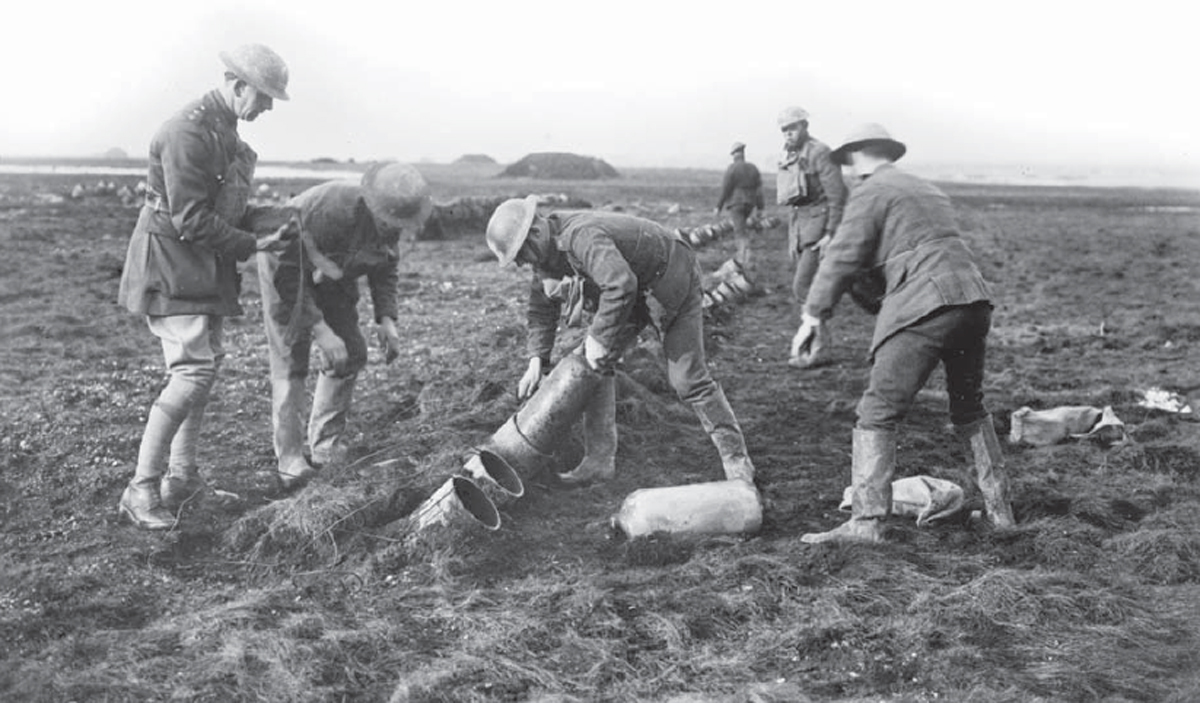
Royal Engineers loading Livens projector tubes prior to a gas shoot. Electric leads had to be attached, and the large bombs slid into the tubes. The use of multiple barrels and rapid or simultaneous discharge meant that an area could quickly be deluged with large concentrations of gas. This increased effect and limited the chance for the enemy to react so men were often caught without their gas masks on. (IWM Q14945)
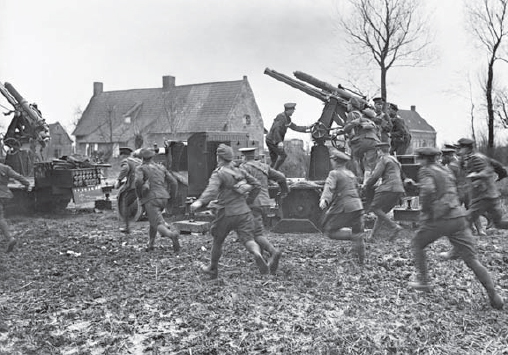
At the approach of hostile aircraft, men of an anti-aircraft section rush to their guns on the outskirts of Armentières, March 1916. The guns are 13-pdr ‘Quick Firers’ on a Mark III motor lorry mounting. The rapid developments of aircraft met with immediate counter-responses in the air and on the ground. (IWM Q460)
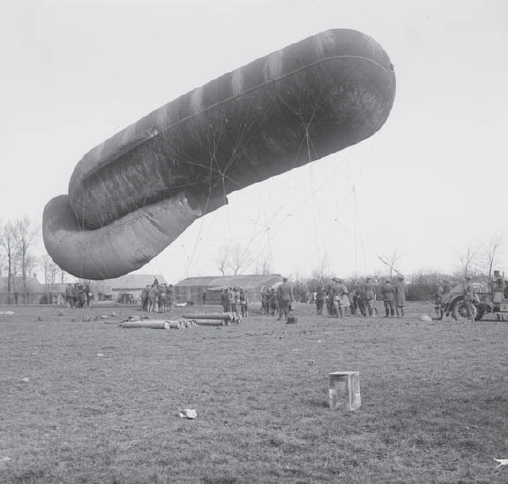
A British observation balloon ascending to observe artillery fire near Locre, 1916. Aerial observation added another dimension to the battlefield, but was not new, having existed from as early as the 1780s. What was new was that balloons were the target of enemy aircraft, and that those being observed now took many different measures to camouflage themselves. Many observers escaped death by taking to parachutes, the main type of which was the ‘Guardian Angel’ stowed in a tube and attached to its user by a rope and harness. (IWM Q449)
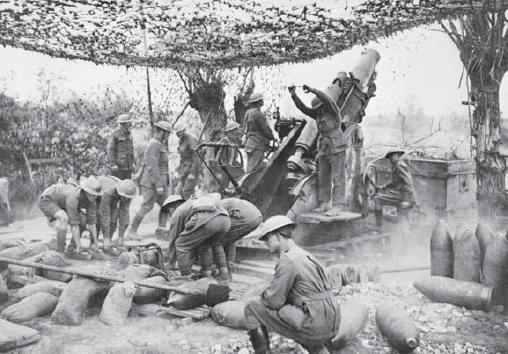
A 9.2inch howitzer of 55th Australian Siege Battery in action at Voormezeele, 13 September 1917. The four men to the rear of the gun lift the shells to the piece in a metal frame. An overhead net provides concealment from the air. (IWM E.AUS.964)
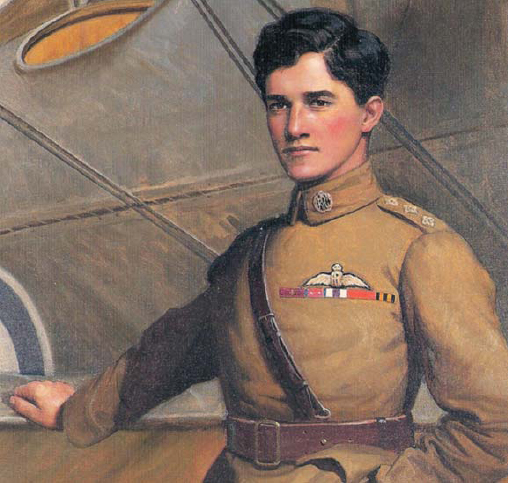
Captain Albert Ball VC DSO MC (1896-1917). Ball volunteered for service with the Sherwood Foresters early in the war, but learned to fly privately and went to France to join the Royal Flying Corps in 1916. With 44 confirmed victories he became one of the best known aces – yet was only 20 years old when killed in May 1917. The precise circumstances of his death are unclear, but his final downing was claimed by Lothar von Richthofen, brother of the more famous Manfred. (Author’s collection)

Illustrations from Work of the RE in the European War, showing the positioning of Livens projectors. (Author’s collection)